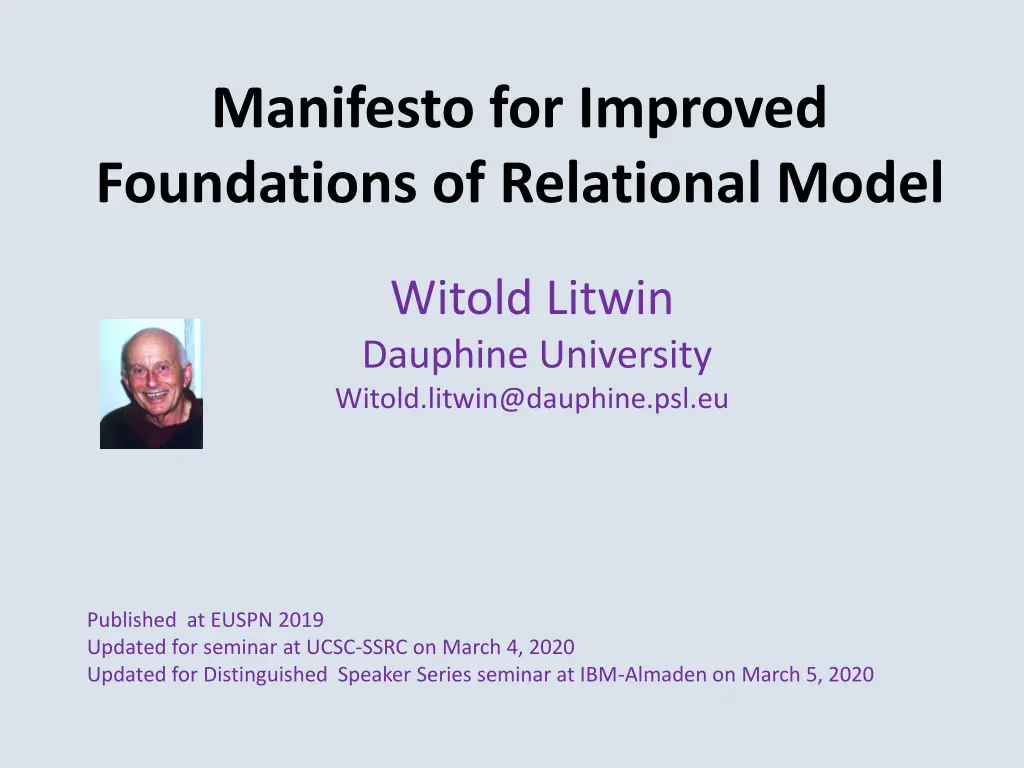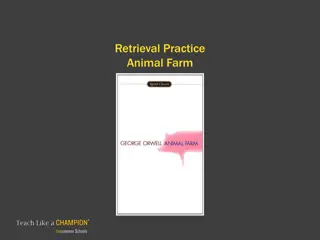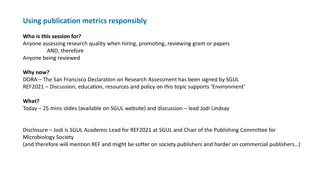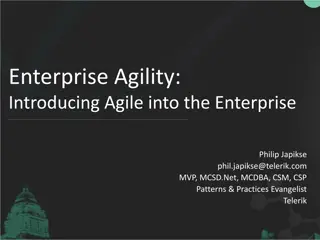
Improved Foundations of Relational Model by Witold Litwin
Explore the manifesto for enhancing the foundations of the relational model presented by Witold Litwin, focusing on extending normalized relations with inherited attributes to achieve greater fidelity to reality, easier querying, and anomaly-free operations. The discussion delves into the importance of implementing relations with stored and inherited attributes and highlights the evolution of relational database technology.
Uploaded on | 0 Views
Download Presentation

Please find below an Image/Link to download the presentation.
The content on the website is provided AS IS for your information and personal use only. It may not be sold, licensed, or shared on other websites without obtaining consent from the author. If you encounter any issues during the download, it is possible that the publisher has removed the file from their server.
You are allowed to download the files provided on this website for personal or commercial use, subject to the condition that they are used lawfully. All files are the property of their respective owners.
The content on the website is provided AS IS for your information and personal use only. It may not be sold, licensed, or shared on other websites without obtaining consent from the author.
E N D
Presentation Transcript
Manifesto for Improved Foundations of Relational Model Witold Litwin Dauphine University Witold.litwin@dauphine.psl.eu Published at EUSPN 2019 Updated for seminar at UCSC-SSRC on March 4, 2020 Updated for Distinguished Speaker Series seminar at IBM-Almaden on March 5, 2020
Whats Up ? Every normalized relation can be extended with inherited attributes (IAs) o Without getting any new anomalies Some extended relations can also become: More faithful to reality Simpler to query Queries typically free of logical navigation Needed for the same queries to the same relations without IAs
Whats Up All these properties are provided at present only by additional specific views of normalized relations To add IAs can be nonetheless always less procedural than to define any such views 3
Whats Up Present relation schemes with foreign keys should even typically suffice oThrough new look at such schemes oAs abbreviations of full schemes with IAs we will show how to define oLike for any abbreviations SSRC, IBM, VIP, MS, SPQR 4
Whats Up Implementing relations with stored and inherited attributes (SIRs) on popular DBSs appears simple. In fact, it s already partially done at majors Foundations of relational model should evolve accordingly 5
Present Foundations Relational database (DB) technology is the core for any type of modern databases: Client, Web, cloud, Big Data You name it There are likely millions of relational DBs around 6
Present Foundations However, relational (data) model overlooked a fundamental issue from the beginning We were all taught that for every normalized relation (table), e.g., in 3rd NF at least, adding an attribute can create a normalization anomaly. 7
Motivating Example : Codds S-P DB S-P1 Scheme Table S Table P Table SP S# Char, SNAME Char, STATUS Char, CITY Char; P# Char, PNAME Char, COLOR Char, WEIGHT Char, S# Char, P# Char, QTY Int, 8
Imagine SP with SNAME SP (S#, SNAME, P#, QTY) oWith FD S.S# SNAME determining SNAME for every SP.S# oe.g. for every SP.S1, SNAME is Smith 2ndNF is gone Normalization anomalies follow 9
Imagine SP with SNAME One has to insert Smith 6 times Instead of once only at present Saving time & storage Inserting Smit by error for, say, S1,P3 becomes possible FD S# SNAME is gone & bad news for queries Etc. 10
Present Foundations Avoid all these drawbacks Use only normalized relations for DB schemes That is why S-P DB is as is. SP especially 11
Price to Pay Query: Every part # supplied by Smith For SP as present: Select P# From SP Left Join on SP.S# = S.S# Where SNAME = Smith For SP with SNAME: Select P# From SP Where SNAME = Smith No more logical navigation Buzz around denormalization some years ago 12
Proposed Foundations Overlooked implicit assumption SNAME is a stored attribute (SA) Base, non-calculable This seemed obvious to (about) everyone For almost 50 years o E.g. see any books about RDBs Codd s seminal proposals included 13
Proposed Foundations SNAME can be an inherited attribute (IA) Calculated through a relational or value expression So to inherit for each SP tuple, SNAME value from S defined by FD we talked about I.e., for every SP.S#, inherited SNAME would be as S.SNAME for S.S# = SP.S# or would be null if such S.S# did not exists E.g. for each SP tuple with S# = S1, SNAME value inherited from S would be Smith 14
Proposed Foundations Operationally, the expression could be as in specific view we show soon Defining mathematically the same relation as denormalized SP with stored SNAME would be SP with inherited SNAME wouldbe then mathematically the same relation But without anomalies 15
Proposed Foundations Formally, the result would be a Stored and Inherited Relation (SIR) E.g. SP (S#, SNAME, P#,QTY) Italics denote an IA See [1] for (much) more on SIRs [1] Litwin, W. SQL for Stored and Inherited Relations. 21stIntl. Conf. on Enterprise Information Systems, (ICEIS 2019), http://www.iceis.org/?y=2019 , 12p. 16
Example SQL view being mathematically the same relation as SP (S#, SNAME, P#,QTY) could be: (1) Create View SP As (Select S#, SNAME, P#, QTY From SP_ Left Join S On (SP_.S# = S.S#)) ; SP_ is renamed SP (S#, P#,QTY) 17
Example Inheritance Expression (IE) defining SNAME in view SP is: SNAME From SP_ Left Join S On (SP_.S# = S.S#) Hence SIR SP could be: (2) Create Table SP (S# Char 5, SNAME, P# Char 5, QTY INT From SP_ Left Join S On (SP_.S# = S.S#) Primary Key (S#, P#)); Here SP_ is the default relation name of all and only SAs in SIR SP Renamed original SP as well 18
Example SP normalization anomalies could similarly concern every other non- key attribute of S or P if in SP SIR SP should be more general 19
Example (3) Create Table SP (S# Char 5, SNAME, STATUS, S.CITY, P# Char 5, PNAME, COLOR, WEIGHT, P.CITY, QTY INT From SP_ Left Join S On (SP_.S# = S.S#) LEFT JOIN P On (SP_.P# = P.P#) Primary Key (S#, P#)); View SP being mathematically the same relation: (4) Create View SP AS (SP_.S#, SNAME, STATUS, S.CITY, SP_.P#, PNAME, COLOR, WEIGHT, P.CITY, QTY From SP_ Left Join S On (SP_.S# = S.S#) LEFT JOIN P On (SP_.P# = P.P#)); 20
Example IE in SIR SP is less procedural than view SP Less mandatory characters to type-in 112 instead of 157 Procedurality (so time) gain of almost 1/3 Non-procedurality was a driving force for Database Science o For the relational model / Codasyl model in particular For entire Computer Science, in fact 21
S-P DB with SIR SP (no anomalies) S-P2 Content Table S S# S1 S2 S3 S4 S5 Table P P# PNAME COLOR WEIGHT CITY P1 Nut Red P2 Bolt Green P3 Screw Blue P4 Screw Red P5 Cam Blue P6 Cog Red SNAME Smith Jones Blake Clark Adams STATUS 20 10 30 20 30 CITY London Paris Paris London Athens 12 17 Paris 17 Oslo 14 London 12 Paris 19 London Lon<don Table SP S# S1 S1 S1 S1 S1 S1 S2 S2 S3 S4 S4 S4 SNAMES Smith Smith Smith Smith Smith Smith Jones Jones 10 Blake Clark Clark Clark STATUS 20 20 20 20 20 20 10 S.CITY London London London London London London Paris Paris Paris London London P# P1 P2 P3 P4 P5 P6 P1 P2 P2 P2 P4 P5 PNAME COLOR WEIGHT P.CITY Nut Red 12 Bolt Green 17 Screw Blue 17 Screw Red 14 Cam Blue 12 Cog Red Nut Red 12 Bolt Green 17 Bolt Green 17 Bolt Green 17 Screw Red 14 Cam Blue 12 QTY 300 London Paris 200 Oslo London 200 Paris 100 London 100 London Paris Paris 200 Paris London Paris 400 19 300 400 30 20 20 20 London 200 300 400 22
Codds S-P DB with view SP (no anomalies) SP_ View SP S# S1 S1 S1 S1 S1 S1 S2 S2 S3 S4 S4 S4 SNAMES Smith Smith 20 Smith Smith Smith 20 Smith 20 Jones Jones 10 Paris Blake 30 Clark 20 Clark 20 Clark 20 London STATUS 20 S.CITY London London London London London London Paris P# P1 P2 P3 P4 P5 P6 P1 P2 P2 P2 P4 P5 PNAME COLOR WEIGHT P.CITY Nut Red 12 Bolt Green 17 Screw Blue 17 Screw Red 14 Cam Blue 12 Cog Red 19 Nut Red 12 Bolt Green 17 Bolt Green 17 Bolt Green 17 Screw Red 14 Cam Blue 12 Paris 400 QTY 300 London Paris 200 Oslo London 200 Paris 100 London 100 London 300 Paris 400 Paris 200 Paris 200 London 300 20 20 400 10 Paris London London 23
S-P DB with denormalized SP (full of anomalies) S-P2 Content Table S S# S1 S2 S3 S4 S5 Table P P# PNAME P1 Nut P2 Bolt P3 Screw Blue P4 Screw Red P5 Cam P6 Cog SNAME Smith Jones Blake Clark Adams STATUS 20 10 30 20 30 CITY London Paris Paris London Athens COLOR WEIGHT CITY 12 17 17 14 12 19 Red Green London Paris Oslo London Paris London Blue Red Table SP S# S1 S1 S1 S1 S1 S1 S2 S2 S3 S4 S4 S4 SNAMES Smith Smith 20 Smith Smith Smith 20 Smith 20 Jones Jones 10 Paris Blake 30 Clark 20 Clark 20 Clark 20 London STATUS 20 S.CITY London London London London London London Paris P# P1 P2 P3 P4 P5 P6 P1 P2 P2 P2 P4 P5 PNAME COLOR WEIGHT P.CITY Nut Red 12 Bolt Green 17 Screw Blue 17 Screw Red 14 Cam Blue 12 Cog Red 19 Nut Red 12 Bolt Green 17 Bolt Green 17 Bolt Green 17 Screw Red 14 Cam Blue 12 Paris 400 QTY 300 London Paris 200 Oslo London 200 Paris 100 London 100 London 300 Paris 400 Paris 200 Paris 200 London 300 20 20 400 10 Paris London London 24
Practical Issue How far can we reduce the procedurality of IE for SP scheme ? Hurray! Typically to ZERO (5) Create Table SP (S# Char 5, P# Char 5, QTY INT Primary Key (S#, P#)); /* Creates the biblical SP May define also SIR SP (3) provided that: Every foreign key implicitly denotes also all the non-key attributes it references Stored or, perhaps, themselves inherited For every foreign key value, the inherited ones are all those for the (same) referenced key value The outer equijoins are implicit 25
What is Foreign Key in Fact ? An attribute referencing a key of a relation Called then referenced key or relation Natural foreign key Same names and same matching values Referenced key is the primary one No referential integrity E.g., SP.S# naturally references S.S# SP.P# naturally references P.P# Declared foreign key A clause defines name and, perhaps value match and referential integrity o On Insert, on update . E.g., SQL Foreign Key clause 26
Practical Issue The explicit result of (5) is SIR SP (3), as stated already, i.e.,: (3) Create Table SP (S# Char 5, SNAME, STATUS, S.CITY, P# Char 5, PNAME, COLOR, WEIGHT, P.CITY, QTY INT From SP_ Left Join S On (SP_.S# = S.S#) LEFT JOIN P On (SP_.P# = P.P#) Primary Key (S#, P#)); Loosely speaking, we see the traditional Create Table SP (5) as an abbreviation of the actual one (3) Same for any Create Table with foreign keys 27
Why New Foundations? With respect to a base relation, added IAs provide for More faithful conceptual model Compare SIR SP and SP_ SP_ is the poorest conceptual model Hardly real SP as in (3) is the richest Most real in other words 28
Why New Foundations? Logical navigation free queries Selects S#, SNAME, P#, PNAME, QTY From SP; Same result query to SP interpreted as at present: Selects S#, SNAME, P#, PNAME, QTY From SP_ Left Join S On (SP_.S# = S.S#) LEFT JOIN P On (SP_.P# = P.P#); Logical navigation doubles the procedurality here 29
Why Logical Navigation Altogether? A typical, real-life inspired, query to a relation with a foreign key needs some referenced attributes as well E.g. A typical Select query to SP needs SNAME or PNAME at least o Cryptic S# or P# alone rarely suffice in real life As long as these attributes are not with foreign keys, logical navigation is a must 30
Why New Foundations? Present practice Extend S-P with specific view SP Defining mathematically the same relation as our SIR SP Our view SP (4) in fact : (4) Create View SP AS (SP_.S#, SNAME, STATUS, S.CITY, SP_.P#, PNAME, COLOR, WEIGHT, P.CITY, QTY From SP_ Left Join S On (SP_.S# = S.S#) LEFT JOIN P On (SP_.P# = P.P#)); Query view SP instead of base table SP 31
Why New Foundations? However, as hinted to, adding IAs to a stored table can be always less procedural than adding equivalent view to the DB As seen for table SP / view SP o Recall the 112 characters for IE in Create Table SP (3) instead of 157 for Create View SP (4) 32
Why New Foundations? As also seen, it can cost even nothing o E.g. our Create Table SP (5) / Create View SP (4) 0 added characters / 157 characters for the view Same for altering SIR SP / view SP 33
Implementing SIRs SIR-layer manages all SIRs Internally calls existing (kernel) SQL DBS (not SIR-enabled) SP, even defined as presently by (5), canonically becomes internally Base SP_ (S#, P#, QTY) View SP (4) SIR-layer canonically directs every query to view SP Discussed logical navigation free queries are OK Simple ? SIR-enabled DBS SIR-layer Kernel SQL DBS 34
Crash Course You consider the traditional: o SP (S#, P#, QTY) From now on, you mean: o SP (S#, SNAME, STATUS, S.CITY, P#, PNAME, COLOR, WEIGHT, P.CITY, QTY) Nothing new, you just transpose a popular idea oUSA, EC, VIP, SIGMOD, VLDB, EDBT Already known to Romans E.g., SPQR & next slide 35
Caseres Art Museum Zoom at the legend 36
Caseres Art Museum C, F, Gl, Popu are Roman foreign keys 37
Crash Course You write for SIR-enabled SQL DBS: Create Table SP (S# Char 5, P# Char 5, QTY INT Primary Key (S#, P#)); DBS extends S# and P# : Create Table SP (S# Char 5, SNAME, STATUS, S.CITY, P# Char 5, PNAME, COLOR, WEIGHT, P.CITY, QTY INT From SP_ Left Join S On (SP_.S# = S.S#) LEFT JOIN P On (SP_.P# = P.P#) Primary Key (S#, P#)) 38
Crash Course SIR-enabled DBS canonically issues to the kernel SQL DBS: Create Table SP_ (S# Char 5, P# Char 5, QTY INT Primary Key (S#, P#)); Create View SP AS (SP_.S#, SNAME, STATUS, S.CITY, SP_.P#, PNAME, COLOR, WEIGHT, P.CITY, QTY From SP_ Left Join S On (SP_.S# = S.S#) LEFT JOIN P On (SP_.P# = P.P#)); 39
Crash Course From now on, SIR-enabled DBS canonically directs every Select query to SP to view SP Queries to S or P and SP are free of usual logical navigation o Over foreign & references keys Without DBA defining any views 40
Crash Course For update queries: Insert, Update, Delete, SIR-enabled DBS processes those towards view SP or table SP_ or, even, other tables in S-P According to view update capabilities of kernel DBS E.g. Some MySQL capabilities lack to SQL-Server Details in the papers on my Web site 41
Conclusion S-P was the mold for about every relational DB. Our examples and the benefits of the IAs extend accordingly Can be expected typical. Every RDBS should be SIR-enabled 1st implementation of SIRs is the next step Proposed foundations should enter teaching & textbooks E.g., Statement: biblical SP should not be extended with SNAME is now fake news 42
Conclusion Better late than never , it should become common knowledge that, unlike today, a normalized relation may: Still have also its all other conceptual attributes: SNAME, , PNAME, Provide for logical navigation free queries Selects S#, SNAME, PNAME, QTY From SP; Even if the relation scheme is simply as at present E.g. for SP 44
Conclusion Need for the logical navigation through base relations or need for a specific view shielding those Becomes only a bad dream Appears retrospectively a mistake Due to lack of SIRs in the original relational model Forbidding exploring foreign keys to the full potential of the concept Common feeling of logical navigation as unnatural in queries appears justified 45
Conclusion Likely, millions of DBAs, clients developers should benefit from SIR-enabled relational DBSs 46
Thanks For Your Attention Witold LITWIN Witold.litwin@dauphine.fr 47






















